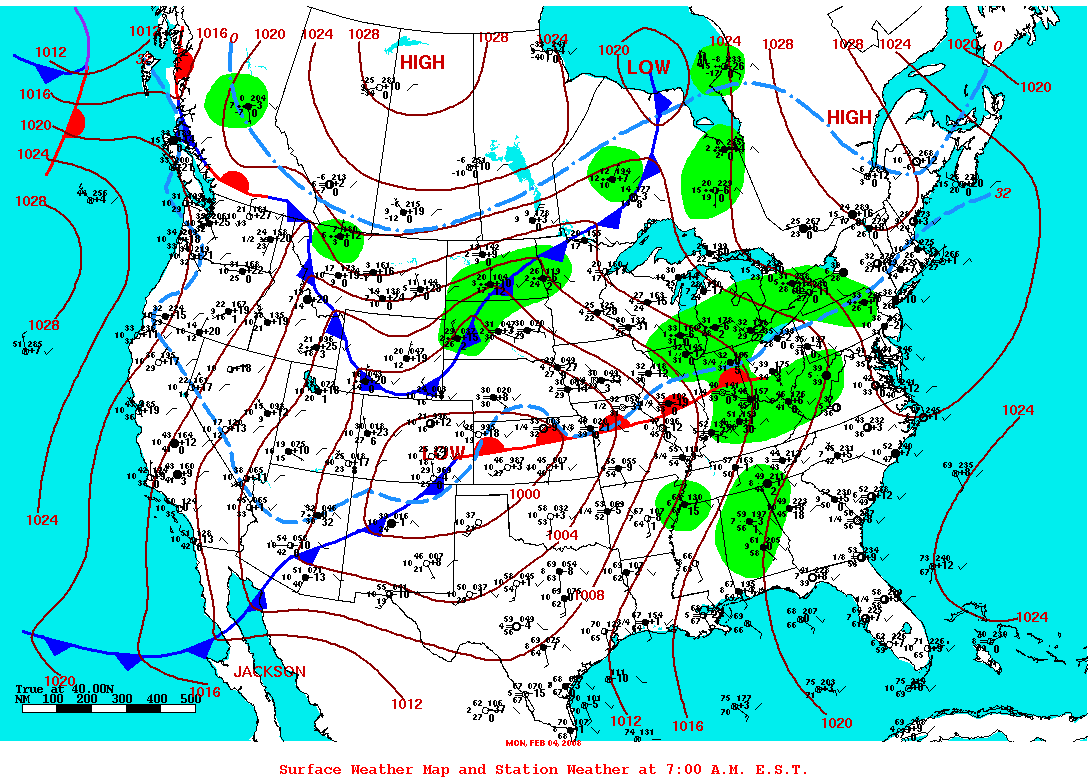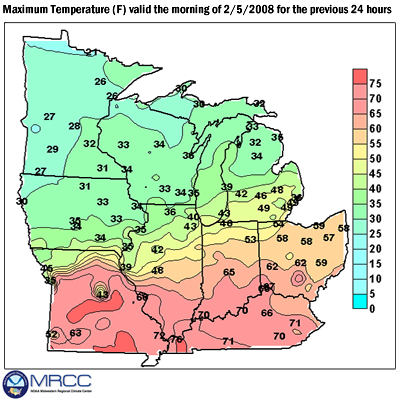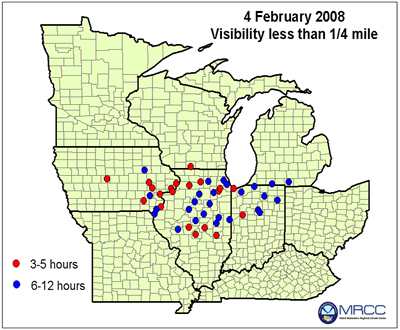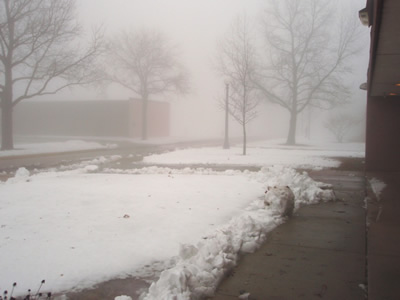Fog
Fog is visible condensation in the air, at or near the ground — basically a ground-based or low-lying cloud. It is composed of tiny water droplets, or in colder weather, ice crystals. Fog is not precipitation, although in the right conditions precipitation (drizzle) can occur. According to the international definition, fog reduces visibility to less than one kilometer (0.62 mile). However, in general use, the term “fog” is any visible condensation in the air (i.e., cloud), at or near the ground, even at higher visibilities. Heavy fog is defined as fog that reduces visibility to 0.25 mile or less. Dense fog is most prevalent in the Midwest from October through March in the hours between midnight and mid-morning.
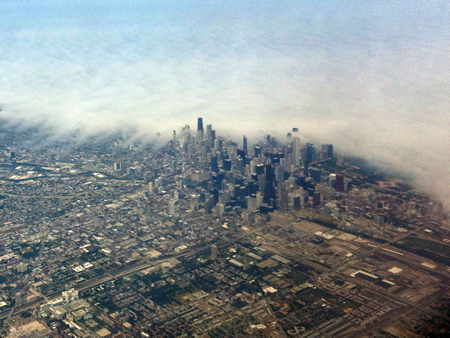
Fog is a common occurrence throughout the Midwest. There are a number of ways fog develops, but the underlying process is the same in each case.
Fog forms when the layer of air near the surface is cooled to its dew point temperature. The dew point temperature is the temperature at which the air will become 100 percent saturated. At 100 percent saturation (100 percent relative humidity) the air can hold no more water molecules as a gas (vapor). If more water molecules (vapor) is added or the air cools further, water vapor in the air will begin to condense into small water droplets. Fog development is sometimes a complex process, and fog does not always form when the relative humidity is 100 percent.
Types of Fog
Radiation Fog
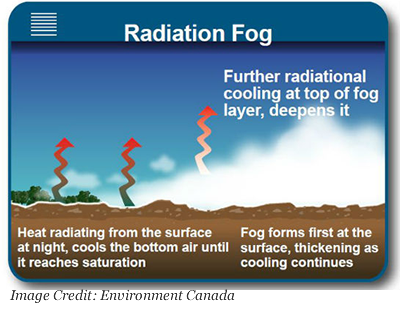
In the spring, summer, and early fall, fog often forms when radiational cooling occurs at night. This often is referred to as ground fog. The layer of air near the surface cools under clear skies because heat absorbed by the surface during the day is released back (radiates) into the atmosphere at night. When the air cools to the point of saturation (its dew point temperature), fog can develop. Radiation fog can be a few feet deep right near or above the ground, or it can be hundreds of feet deep. The fog's thickness depends on the depth of the cool, moist layer of air. If you are outdoors when fog begins to form you may notice that it is first visible as a thin layer or patches near the ground, then gets deeper as the air continues to cool. Since the lowest temperature overnight typically occurs in pre-dawn hours, fog is most common in the early morning.

Fog as a result of radiational cooling has formed a thin layer close to the ground.
Source: iWitness on weather.com
Ground fog can reduce visibility to near zero at times, but visibility can be highly variable. Cool air tends to pool in valleys or lower elevations in the terrain causing fog to be denser in these locations. One of the hazards with this type of fog is that one can encounter rapidly changing visibility, from a few miles to just a few feet, in a short distance while traveling roads and highways.
Valley Fog
Valley fog is fog that occurs in mountain valleys, river valleys, and other low areas. This is just another type of radiation fog. As the colder, denser air flows into the valleys, water vapor in the air condenses forming fog.
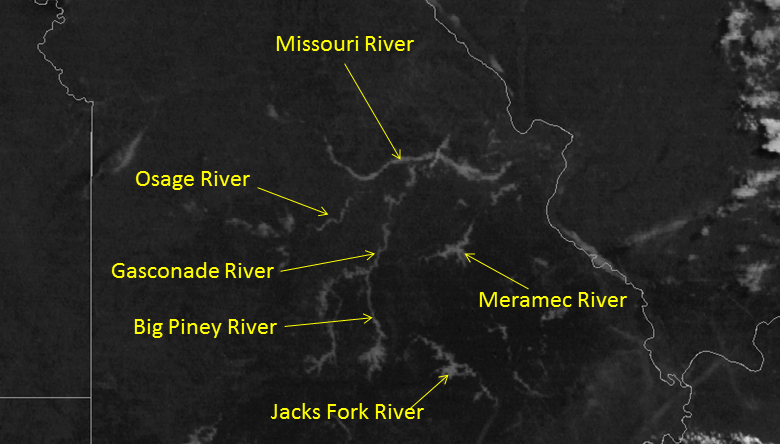
This image shows an example of valley fog detected by early-morning visible satellite pictures. The fog formed because water temperatures were in the upper 60s and 70s, while the clear skies and light winds during the overnight hours allowed air temperatures to drop into the lower and middle 60s. Fog developed in the river valleys as the air temperature cooled below the water temperature and down to the air's dew point temperature. Image credit: NWS St. Louis.
Ground fog will generally start to dissipate after the sun rises and the lower atmosphere begins to warm. In essence, as the air warms, it gains the capacity to have more vapor and the tiny water droplets evaporate. If skies are overcast, preventing the ground from heating up and therefore warming the air near the surface, the fog could persist through much of the day depending on how much warming is able to take place.
Advection Fog
Advection is the horizontal movement of an atmospheric property (temperature, moisture, etc.) from one place to another by the wind. Advection fog is produced when warm, moist air moves over a cold surface, such as snow-covered ground or a body of cooler water. The originally warm air was able to hold more water vapor than the now cooling air, causing some of the vapor to condense into water droplets. This type of fog typically occurs in the winter and early spring. It often covers a large area and can be very persistent.
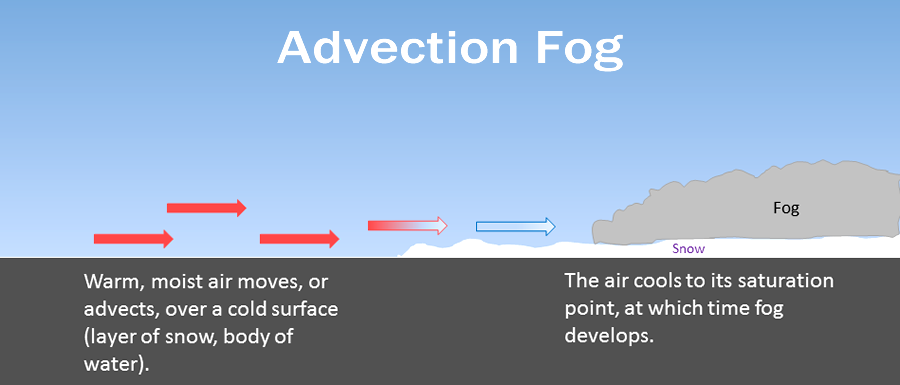
Advection fog can also cause accelerated snow melt. The latent heat of condensation, the heat energy released when water vapor condenses to form liquid droplets, is substantial. For every gram of water vapor condensed over a snow surface, enough heat energy is released to melt seven times as much snow. This causes snow to melt rapidly, even in cases of no sun and temperatures just above freezing.
Evaporation (Steam) Fog
The previous three types of fog developed because air that had lots of water vapor molecules, cooled below its saturation point and forced some of those vapor molecules to condense into water droplets. However, the reverse can also happen where water vapor molecules are added to the air near the surface to the point where the air can no longer hold any more water molecules as vapor. Any additional water molecules will have to condense together to form water droplets.
This is most common over wet surfaces such as after a rain event on a warm day or over a body of water. On a warm day, the ground surface will warm. If it rains, water is touching the warm surface, encouraging that water to evaporate – adding vapor to the air above the surface. Often the air is cooler after a rain event, so the addition of so much vapor into cooler air which quickly saturate the air and force condensation of the vapor molecules into suspended water droplets. Over a body of water, particularly in the fall or late spring, the air above the surface will cool faster than the water. Water is always evaporating (even in saturated air!), so if the air near the surface cools below its dew temperature while the water is continuously adding water vapor molecules to the air, the water vapor in the air will start to condense and form fog.
Evaporation fog is often referred to as steam fog since the appearance often looks like steam coming off the road or bodies of water. Steam fog can develop as the result of radiational cooling, or by the advection of colder air over a warmer body of water.

Steam fog over Lake Michigan in January.
Photo by David C. Rogers from Lake-ICE project.
 Steam Fog on a spring morning - May 12, 2010.
Steam Fog on a spring morning - May 12, 2010. Photographer: Don G. Lambert, epod.usra.edu
Other Factors Affecting Fog Development
Particularly in the Midwest, fog also can occur under cloudy conditions often following a frontal or low pressure system. Light precipitation that occurs adds moisture to the air aloft priming the atmospheric for fog. Fog developing in these conditions can be quite deep and widespread. Precipitation, radiational cooling, and advection play varying roles in this mixed fog type category.
Fog sometimes occurs during periods of melting snow, lasting through daylight hours. The snow is continuously sublimating (similar to evaporation but for ice instead of liquid), adding water vapor molecules to already cool air that can quickly become saturated.
Impacts of Fog
The largest impacts of fog are to transportation, particularly airport operations and highway travel, but also marine and rail travel. Impacts can range from annoyance due to delayed travel to deadly multiple-vehicle highway accidents. Persistent, dense fog can ground or severely slow air travel. Weather-related crashes, of which fog is one cause, cost an average of $42 billion annually in the United States from personal injury, loss of life, and property damage. The estimated cost of weather-related delay to trucking companies ranges from $2.2 to $3.5 billion annually. Each year, $4.2 billion is lost due to air traffic delays attributed to weather.
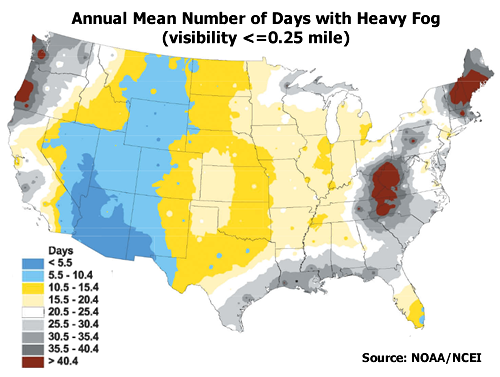
Dense fog over highways can reduce visibility to only tens of feet making it dangerous to travel, even with headlights. The lower visibility and lack of contrast, especially at night, makes it difficult for drivers to judge distance and speed. Our cues as to how fast we are traveling are often taken from a reference to objects we see, such as trees, telephone poles, or signs. At night, fog droplets scatter the light from headlights back to the eye reducing their effectiveness to detect contrast. Road markings, signs and other objects may not be readily visible. Depth perception may also be affected. Drivers may judge an object, like a car in front of them, to be farther away that it is, thus delaying their reaction time. Dense fog has resulted in numerous multi-vehicle pileups on roads in the United States and other countries.

200-car accident due to dense fog near Long Beach, California. Date unknown. Source: YouTube
An added hazard during the winter is freezing fog. Freezing fog occurs when the air temperature is below freezing and the water droplets in the fog become supercooled. Supercooled water droplets stay in liquid form until they come into contact with a surface that is below freezing, such as a paved road. This produces a thin coating of ice that makes road travel extremely hazardous especially on untreated roads. Freezing fog can also result in rime icing on trees, powerlines, and other objects.

Rime icing on trees from freezing fog. Photo by Steve Hilberg.

Close-up of rime icing. Photo by Steve Hilberg.
Benefits of Fog
It may not be obvious, but fog does have some environmental benefits. In coastal areas such as the sequoia forests in California, ferns, trees and other plants have adapted to “collect” the small water droplets in fog for their water needs. In some parts of the world, fog “harvesting” is being used to collect water for domestic and agricultural use. Large mesh nets are erected to capture the water droplets. The water drips down to a gutter at the bottom of the mesh frame and then is channeled through piping to a storage tank. Fog harvesting is feasible only where the winds, altitude, and frequency of fog are favorable, typically in mountainous areas along coasts.
Fog Safety
Fog can be one of the most dangerous driving hazards you can encounter. If you must drive in foggy conditions follow these safety tips. Most multi-car accidents in fog are the result of drivers traveling too fast for conditions.
- Slow down.
- Be alert! Visibility in fog can change without warning.
- Increase the distance between your car and the car in front of you to ensure enough reaction time and stopping distance.
- Turn on all your lights. Use low beam headlights and fog lights. Do not use high beams.
- If you are moving slower than traffic, turn on your 4-way flashers to give vehicles approaching from behind a better opportunity to see and notice your vehicle. (Check state laws regarding use of flashers while moving.)
- Use windshield wipers and defroster as necessary to maximize visibility.
- Be ready for emergency stops by other vehicles. Vehicles may be closer than they initially appear to be.
- If possible, drive in a “pocket” where no other vehicles are around you.
- Turn off your cruise control so you are in control of your vehicle.
- Use the right edge of the road or roadside reflectors as a guide.
- Listen for traffic you can’t see.
- Do not change lanes or pass other vehicles, unless absolutely necessary.
- Remember that other drivers are driving in the same conditions with the same impairments to visibility.
- Signal early, and avoid sudden braking if possible..
- Watch out for slow-moving and parked vehicles.
- If you cannot see, pull completely off the road, preferably at a rest area or truck stop.
- Driving in dense fog for any length of time can be fatiguing. If possible, take frequent breaks to rest your eyes.
- If you pull off to the side of the road, turn on your hazard flashers immediately.
